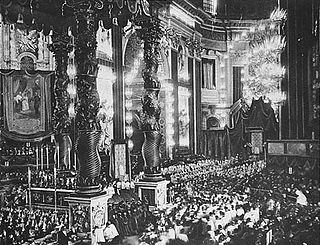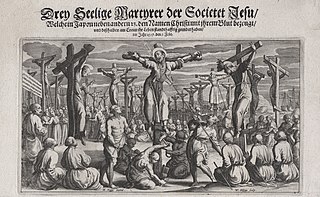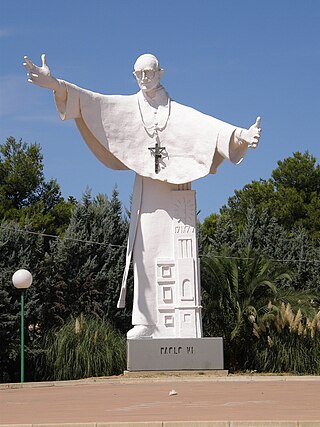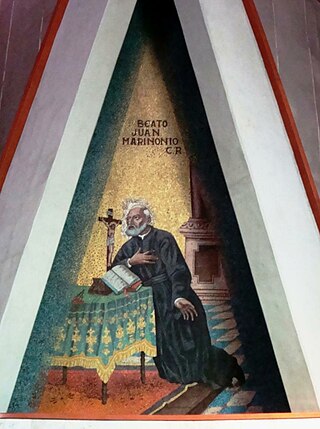
Canonization is the declaration of a deceased person as an officially recognized saint, specifically, the official act of a Christian communion declaring a person worthy of public veneration and entering their name in the canon catalogue of saints, or authorized list of that communion's recognized saints.

In the Catholic Church, the Dicastery for the Causes of Saints, previously named the Congregation for the Causes of Saints, is the dicastery of the Roman Curia that oversees the complex process that leads to the canonization of saints, passing through the steps of a declaration of "heroic virtues" and beatification. After preparing a case, including the approval of miracles, the case is presented to the pope, who decides whether or not to proceed with beatification or canonization.

Joan of Arc (1412–1431) was formally canonized as a saint of the Roman Catholic Church on 16 May 1920 by Pope Benedict XV in his bull Divina disponente, which concluded the canonization process that the Sacred Congregation of Rites instigated after a petition of 1869 of the French Catholic hierarchy. Although pro-English clergy had Joan burnt at the stake for heresy in 1431, she was rehabilitated in 1456 after a posthumous retrial. Subsequently, she became a folk saint among French Catholics and soldiers inspired by her story of being commanded by God to fight for France against England. Many French regimes encouraged her cult, and the Third Republic was sympathetic to the canonization petition prior to the 1905 separation of church and state.
The process of beatification and canonization has undergone various reforms in the history of the Roman Catholic Church. For current practice, as well as a discussion of similar processes in other churches, see the article on canonization. This article describes the process as it was before the promulgation of the Codex Iuris Canonici of 1983.

The Forty Martyrs of England and Wales or Cuthbert Mayne and Thirty-Nine Companion Martyrs are a group of Catholic, lay and religious, men and women, executed between 1535 and 1679 for treason and related offences under various laws enacted by Parliament during the English Reformation. The individuals listed range from Carthusian monks who in 1535 declined to accept Henry VIII's Act of Supremacy, to seminary priests who were caught up in the alleged Popish Plot against Charles II in 1679. Many were sentenced to death at show trials, or with no trial at all.

Bartholomew of Braga, born Bartolomeu Fernandes and in religious Bartolomeu dos Mártires, was a Portuguese Catholic and a professed member from the Order of Preachers as well as the Archbishop Emeritus of Braga. Fernandes participated in the Council of Trent and also collaborated with Charles Borromeo at the council while also establishing a series of hospitals and hospices in Braga while publishing a range of works from catechism to other topics.

Szymon of Lipnica was a Polish catholic priest and a professed member from the Order of Friars Minor. He became a sought after and noted preacher and took as his preaching inspiration Saint Bernardine of Siena and also was a strong proponent of popular devotions that he worked to spread.
During the Spanish Civil War Catholic people faced persecution from the Republican faction of the war, in part due to their support of the nationalists and the recently abolished monarchy. The Catholic Church venerates them as martyrs. More than 6,800 clerics and other Catholic people were killed in what has been dubbed the Red Terror. As of November 2023, 2,127 Spanish martyrs have been beatified; 11 of them being canonized. For some 2,000 additional martyrs, the beatification process is underway

The Martyrs of Japan were Christian missionaries and followers who were persecuted and executed, mostly during the Tokugawa shogunate period in the 17th century. The Japanese saw the rituals of the Christians causing people to pray, close their eyes with the sign of the cross and lock their hands together – this was seen as psychological warfare against the Japanese and this was punished as such. More than 400 martyrs of Japan have been recognized with beatification by the Catholic Church, and 42 have been canonized as saints.

Pope John Paul II reigned as pope of the Roman Catholic Church and sovereign of the Vatican City State for 26 years from October 1978 to his death, on 2 April 2005. Since his death, many thousands of people have been supporting the case for beatifying and canonising Pope John Paul II as a saint. His formal beatification ceremony took place on 1 May 2011.
The canonization process of Pope Pius XII dates to shortly after his death in 1958. He was declared a servant of God in 1990 and venerable in 2009. Father Peter Gumpel was the relator of Pius XII's cause for canonization. The potential beatification of Pius XII has raised concern, especially by Jewish organisations, because of his controversial record during the Holocaust. The objections especially arise because of the refusal by the Vatican to allow independent access to the Vatican's archives for the period of Pius XII's papacy.

The cause for the canonization of Pope Paul VI, who died in 1978, commenced in 1993 and he was canonized on 14 October 2018. After having been proclaimed a Servant of God and declared Venerable, he was beatified on 19 October 2014, after the recognition of a miracle had been attributed to his intercession, and declared a saint by Pope Francis on 14 October 2018.

Saint Joseph Gabrielof the Rosary, also referred to as Priest Brochero, was a Catholic priest who suffered leprosy throughout his life. He is known for his extensive work with the poor and the sick. He became affectionately known as "the Gaucho priest" and the "cowboy priest".

María de la Purísima Salvat Romero, born María Isabel Salvat Romero, was a Spanish religious sister of the sisters of the Company of the Cross. She assumed the religious name María de la Purísima of the Cross.

Francesco Marinoni was an Italian Roman Catholic priest who was a member of the Theatines. He assumed the name Giovanni upon his admittance into the order. His cult was confirmed and acted as his formal beatification in 1764 under Pope Clement XIII. His life of heroic virtue was approved and Pope Benedict XVI added the title of Venerable to him despite the fact he was beatified. A miracle - now under investigation - is needed for his canonization.













